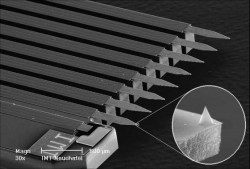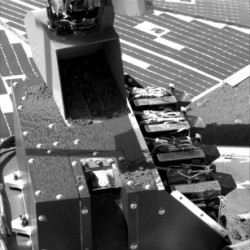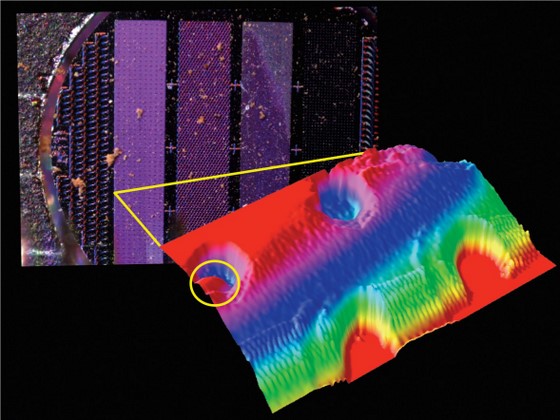[/caption]
What is Mars ubiquitous dust really like, close-up? Scientists from the Phoenix missions are finding out with the Atomic Force Microscope (AFM), an instrument that is providing the highest magnification of anything seen from another world. A couple of months ago the Phoenix Mars Lander used its optical microscope to image small grains of the Martian soil. Now, the spacecraft has switched on the AFM to take the first-ever 3-dimensional image of a single particle of Mars’ dust. The AFM can detail the shapes of particles as small as about 100 nanometers, about one one-thousandth the width of a human hair. That is about 100 times greater magnification the optical microscope. The article is rounded, and about one micrometer, or one millionth of a meter, across. It is a speck of the dust that cloaks Mars. Such dust particlets color the Martian sky pink, feed storms that regularly envelop the planet and produce Mars’ distinctive red soil.
“This is the first picture of a clay-sized particle on Mars, and the size agrees with predictions from the colors seen in sunsets on the Red Planet,” said Phoenix co-investigator Urs Staufer of the University of Neuchatel, Switzerland, who leads a Swiss consortium that made the microscope.
“Taking this image required the highest resolution microscope operated off Earth and a specially designed substrate to hold the Martian dust,” said Tom Pike, Phoenix science team member from Imperial College London. “We always knew it was going to be technically very challenging to image particles this small.”

The device took about a dozen years to develop. The AFM maps the shape of particles in three dimensions by scanning them with a sharp tip at the end of a spring. During the scan, invisibly fine particles are held by a series of pits etched into a substrate microfabricated from a silicon wafer.
“I’m delighted that this microscope is producing images that will help us understand Mars at the highest detail ever,” Staufer said. “This is proof of the microscope’s potential. We are now ready to start doing scientific experiments that will add a new dimension to measurements being made by other Phoenix lander instruments.”
“After this first success, we’re now working on building up a portrait gallery of the dust on Mars,” Pike added.
Mars’ ultra-fine dust is the medium that actively links gases in the Martian atmosphere to processes in Martian soil, so it is critically important to understanding Mars’ environment, the researchers said.

The particle seen in the atomic force microscope image was part of a sample scooped by the robotic arm from the “Snow White” trench and delivered to Phoenix’s microscope station in early July. The microscope station includes the optical microscope, the atomic force microscope and the sample delivery wheel. It is part of a suite of tools called Phoenix’s Microscopy, Electrochemistry and Conductivity Analyzer.
Source: Phoenix News Site


all right! half a billion dollars so we can look at dirt under a microscope
Cool. They’ve looked at dirt from another planet. Whoopee.
Seriously, with luck, this technology may find a use here on Earth.